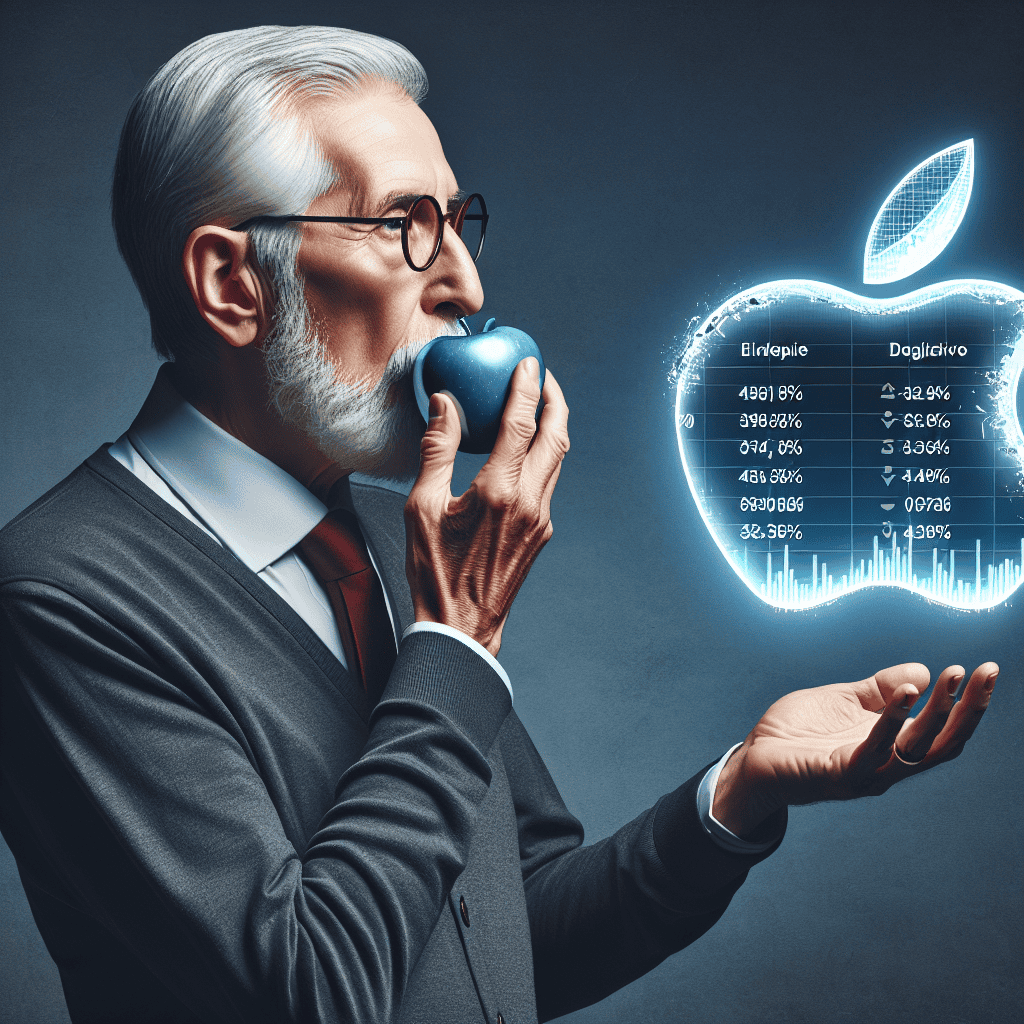“Buffett’s Bold Move: Slashing Apple, Betting Big on 2024’s Game-Changing Split!”
Introduction
In a surprising strategic shift, Warren Buffett, the legendary investor and CEO of Berkshire Hathaway, has significantly reduced his holdings in Apple Inc., cutting his stake by 56%. This move marks a notable departure from his long-standing confidence in the tech giant, which has been a cornerstone of Berkshire’s portfolio. Simultaneously, Buffett has redirected his investment focus towards a major reverse stock split anticipated in 2024, signaling a potential new direction in his investment strategy. This decision reflects Buffett’s adaptive approach to market dynamics and his continuous pursuit of value in evolving economic landscapes. As investors and analysts closely monitor these developments, Buffett’s actions may have far-reaching implications for market trends and investment strategies in the coming year.
Impact Of Warren Buffett’s Decision On Apple Stock Prices
Warren Buffett, the legendary investor and CEO of Berkshire Hathaway, has long been known for his strategic investment decisions that often send ripples through the financial markets. Recently, Buffett made headlines by reducing his holdings in Apple Inc. by a staggering 56%. This move has sparked widespread speculation and analysis among investors and market analysts, as Apple has been one of Berkshire Hathaway’s most significant and successful investments in recent years. The decision to cut back on Apple shares raises questions about the future trajectory of the tech giant’s stock prices and the broader implications for the market.
Apple, a company that has consistently demonstrated robust financial performance and innovation, has been a cornerstone of Berkshire Hathaway’s portfolio. Buffett’s decision to reduce his stake in Apple suggests a shift in his investment strategy, which could be driven by several factors. One possible reason for this move could be the desire to diversify Berkshire Hathaway’s portfolio further, reducing its heavy reliance on a single tech stock. Additionally, with Apple’s stock reaching new heights, Buffett might be capitalizing on the opportunity to realize significant gains from his investment.
The impact of Buffett’s decision on Apple stock prices is multifaceted. In the short term, the announcement of such a substantial reduction in holdings can lead to a decline in stock prices as investors react to the news. This reaction is often driven by the perception that if a seasoned investor like Buffett is selling, there might be underlying concerns about the company’s future performance. Consequently, other investors may follow suit, leading to increased selling pressure and a potential dip in stock prices.
However, it is essential to consider the long-term implications of this decision. While the initial reaction may be negative, Apple’s strong fundamentals and continued innovation could help stabilize and even boost its stock prices over time. The company’s ability to adapt to changing market conditions and its track record of delivering value to shareholders may reassure investors and mitigate the impact of Buffett’s decision.
Moreover, Buffett’s move to invest in a major reverse stock split scheduled for 2024 adds another layer of complexity to the situation. A reverse stock split, which involves reducing the number of a company’s outstanding shares while increasing the share price proportionally, is often seen as a strategy to enhance a company’s market perception and attract institutional investors. By investing in a company undergoing a reverse stock split, Buffett may be signaling confidence in its potential for growth and value creation.
This strategic shift in Buffett’s investment approach highlights the dynamic nature of the financial markets and the need for investors to remain vigilant and adaptable. While the reduction in Apple holdings may initially cause concern, it is crucial to recognize that investment decisions are often influenced by a myriad of factors, including market conditions, company performance, and broader economic trends.
In conclusion, Warren Buffett’s decision to reduce his Apple holdings by 56% and invest in a major reverse stock split for 2024 has significant implications for Apple stock prices and the broader market. While the immediate impact may be a decline in stock prices, the long-term effects will depend on Apple’s ability to maintain its competitive edge and deliver value to shareholders. As always, investors should carefully consider the broader context and underlying factors driving such decisions, recognizing that the financial markets are inherently complex and ever-evolving.
Understanding Reverse Stock Splits: A 2024 Perspective
In the ever-evolving landscape of financial markets, strategic decisions by influential investors often serve as a bellwether for broader market trends. Recently, Warren Buffett, the legendary investor and CEO of Berkshire Hathaway, made headlines by reducing his holdings in Apple by a staggering 56%. This move has sparked widespread speculation and analysis, as Apple has long been a cornerstone of Berkshire Hathaway’s investment portfolio. However, Buffett’s decision to pivot away from Apple is not merely a reactionary measure but rather a calculated strategy aligned with his investment philosophy. As he reallocates resources, Buffett has turned his attention to a major reverse stock split anticipated in 2024, signaling a shift in focus that warrants closer examination.
To understand the implications of Buffett’s recent moves, it is essential to first grasp the concept of a reverse stock split. Unlike a traditional stock split, where a company increases its number of shares to make them more affordable, a reverse stock split reduces the number of shares outstanding, thereby increasing the share price. This maneuver is often employed by companies seeking to enhance their stock’s appeal to institutional investors or to meet minimum price requirements for stock exchange listings. In 2024, a significant reverse stock split is expected to occur, capturing the attention of astute investors like Buffett.
Buffett’s decision to invest in this upcoming reverse stock split reflects his keen ability to identify opportunities where others may see risk. By reducing his Apple holdings, Buffett is not necessarily expressing a lack of confidence in the tech giant’s future prospects. Instead, he is reallocating capital to seize potential gains from the anticipated reverse stock split. This move underscores Buffett’s long-standing investment principle of seeking value and growth potential, even if it means diverging from conventional wisdom.
Moreover, Buffett’s strategic shift highlights the importance of adaptability in investment strategies. As market dynamics evolve, so too must the approaches of even the most seasoned investors. By embracing the potential of a reverse stock split, Buffett is demonstrating his willingness to explore new avenues for growth, while still adhering to his core investment tenets. This adaptability is a hallmark of Buffett’s success and serves as a valuable lesson for investors navigating the complexities of modern financial markets.
In addition to showcasing Buffett’s strategic acumen, this development also prompts a broader discussion about the role of reverse stock splits in today’s investment landscape. While some investors may view reverse stock splits with skepticism, fearing they signal underlying financial distress, others recognize their potential to unlock value and attract new investment. As companies increasingly turn to reverse stock splits as a tool for financial engineering, understanding their implications becomes crucial for investors seeking to make informed decisions.
In conclusion, Warren Buffett’s recent reduction of Apple holdings and investment in a major reverse stock split anticipated in 2024 exemplifies his strategic foresight and adaptability. By reallocating resources to capitalize on emerging opportunities, Buffett continues to demonstrate his mastery of value investing. As the financial landscape continues to evolve, investors would do well to heed the lessons of adaptability and strategic vision embodied by Buffett’s latest moves. Through careful analysis and a willingness to embrace change, investors can navigate the complexities of modern markets and uncover new avenues for growth and success.
Warren Buffett’s Investment Strategy: Lessons From The Apple Reduction
Warren Buffett, the legendary investor and CEO of Berkshire Hathaway, has long been a figure of fascination in the financial world. His investment decisions are closely scrutinized, as they often signal broader market trends or shifts in economic sentiment. Recently, Buffett made headlines by reducing his holdings in Apple by 56%, a move that has sparked considerable discussion among investors and analysts alike. This decision, coupled with his investment in a major reverse stock split anticipated in 2024, offers valuable insights into his investment strategy and the principles that guide his financial decisions.
Buffett’s reduction in Apple holdings is particularly noteworthy given his previous enthusiasm for the tech giant. Apple has been a cornerstone of Berkshire Hathaway’s portfolio, contributing significantly to its growth over the past few years. However, Buffett’s decision to scale back his investment suggests a strategic reevaluation rather than a loss of confidence in the company. It is important to understand that Buffett’s investment philosophy is deeply rooted in value investing, which emphasizes the intrinsic value of a company rather than short-term market fluctuations. By reducing his stake in Apple, Buffett may be signaling that the stock has reached a valuation that no longer aligns with his criteria for value investing.
Moreover, this move could also reflect a broader diversification strategy. Buffett has often emphasized the importance of not putting all one’s eggs in one basket. By reallocating resources from Apple, he may be seeking to balance his portfolio and mitigate potential risks associated with overexposure to a single stock or sector. This approach underscores the importance of diversification in managing investment risk, a lesson that is particularly relevant in today’s volatile market environment.
In addition to reducing his Apple holdings, Buffett’s investment in a major reverse stock split anticipated in 2024 has also captured attention. A reverse stock split is a corporate action in which a company reduces the number of its outstanding shares, thereby increasing the per-share price. This move is often seen as a way to enhance a company’s image and attract more institutional investors. Buffett’s interest in this particular reverse stock split suggests that he sees potential for significant value creation. It also highlights his willingness to explore opportunities that may not be immediately apparent to the broader market.
This strategic pivot towards a reverse stock split aligns with Buffett’s long-standing belief in the importance of investing in companies with strong fundamentals and growth potential. By identifying opportunities that others might overlook, Buffett continues to demonstrate his acumen in navigating complex market dynamics. His actions serve as a reminder of the importance of thorough research and analysis in making informed investment decisions.
In conclusion, Warren Buffett’s recent investment moves offer valuable lessons for investors. His reduction in Apple holdings underscores the importance of reevaluating investments in light of changing market conditions and valuations. Meanwhile, his interest in a major reverse stock split highlights the potential for value creation in unconventional opportunities. As always, Buffett’s actions reflect his commitment to a disciplined, value-oriented investment strategy that prioritizes long-term growth over short-term gains. Investors would do well to heed these lessons as they navigate the ever-evolving financial landscape.
The Future Of Apple: Analyzing The 56% Stake Reduction

In a surprising move that has captured the attention of investors and analysts alike, Warren Buffett’s Berkshire Hathaway has reduced its holdings in Apple by 56%. This decision marks a significant shift in the investment strategy of one of the most renowned investors in the world, raising questions about the future trajectory of Apple and the broader technology sector. As we delve into the implications of this decision, it is essential to consider the factors that may have influenced Buffett’s choice and the potential impact on Apple’s market position.
To begin with, Warren Buffett’s investment philosophy has always been characterized by a focus on value investing, seeking companies with strong fundamentals and long-term growth potential. His substantial investment in Apple, which began in 2016, was initially seen as a departure from his traditional avoidance of technology stocks. However, Apple’s consistent performance, robust ecosystem, and loyal customer base made it an attractive proposition. The decision to reduce the stake by more than half suggests a reassessment of Apple’s future prospects, possibly influenced by the evolving landscape of the technology industry.
One possible reason for this reduction could be the increasing competition Apple faces in the global market. With companies like Samsung, Huawei, and emerging players from China intensifying their efforts to capture market share, Apple is under pressure to innovate continuously. Moreover, the saturation of the smartphone market in developed countries poses a challenge to Apple’s growth, as it relies heavily on iPhone sales for revenue. This competitive environment may have prompted Buffett to reconsider the long-term growth potential of Apple, leading to the significant reduction in holdings.
Furthermore, the decision to invest in a major reverse stock split scheduled for 2024 indicates a strategic pivot towards opportunities that may offer higher returns. Reverse stock splits are often employed by companies to consolidate shares and increase the stock price, potentially attracting a different class of investors. By investing in such a move, Buffett may be signaling confidence in the underlying value of the company undergoing the split, anticipating that it will enhance shareholder value in the long run.
It is also worth noting that Buffett’s decision could be influenced by macroeconomic factors, such as rising interest rates and inflationary pressures, which have led to increased volatility in the stock market. In such an environment, reallocating resources to investments perceived as more stable or undervalued could be a prudent strategy. This shift may reflect a broader trend among investors seeking to mitigate risk while capitalizing on emerging opportunities.
Despite the reduction in holdings, it is important to recognize that Apple remains a formidable player in the technology sector. The company’s strong brand loyalty, innovative product pipeline, and expanding services segment continue to provide a solid foundation for future growth. While Buffett’s decision may raise concerns among some investors, it does not necessarily indicate a lack of confidence in Apple’s ability to navigate the challenges ahead.
In conclusion, Warren Buffett’s decision to reduce his stake in Apple by 56% and invest in a major reverse stock split for 2024 underscores the dynamic nature of investment strategies in response to changing market conditions. As the technology landscape continues to evolve, investors will be closely monitoring Apple’s performance and strategic initiatives to assess its ability to maintain its leadership position. Ultimately, this development serves as a reminder of the complexities involved in investment decisions and the need for adaptability in an ever-changing economic environment.
Reverse Stock Splits: What Investors Need To Know In 2024
In the ever-evolving landscape of financial markets, investors are constantly seeking strategies to optimize their portfolios and maximize returns. One of the most intriguing developments in 2024 is the decision by Warren Buffett, the legendary investor and CEO of Berkshire Hathaway, to significantly reduce his holdings in Apple by 56% and redirect his focus towards a major reverse stock split. This move has sparked considerable interest and discussion among investors, prompting a closer examination of reverse stock splits and their implications for the investment community.
To begin with, a reverse stock split is a corporate action in which a company reduces the number of its outstanding shares, thereby increasing the per-share price. This is achieved by consolidating multiple shares into a single share. For instance, in a 1-for-10 reverse stock split, every ten shares held by an investor are combined into one share. While the total value of the investment remains unchanged, the number of shares decreases, and the price per share increases proportionally. Companies typically undertake reverse stock splits to enhance their stock’s appeal, improve liquidity, and meet exchange listing requirements.
Warren Buffett’s decision to invest in a major reverse stock split in 2024 underscores the potential benefits and strategic considerations associated with this corporate maneuver. By reducing his Apple holdings, Buffett is signaling a shift in focus towards opportunities that may arise from companies undergoing reverse stock splits. This move suggests that he perceives value in the potential for these companies to enhance their market position and attract a broader investor base.
Moreover, reverse stock splits can serve as a catalyst for positive change within a company. They often indicate management’s confidence in the company’s future prospects and can be a precursor to improved financial performance. By consolidating shares, companies can project a more favorable image to investors, potentially leading to increased interest from institutional investors and analysts. This, in turn, can result in greater market visibility and enhanced trading volumes.
However, it is essential for investors to approach reverse stock splits with a discerning eye. While they can offer potential benefits, they are not without risks. In some cases, companies may resort to reverse stock splits as a last-ditch effort to prop up a declining stock price. This can be a red flag, indicating underlying financial challenges that may not be immediately apparent. Therefore, investors should conduct thorough due diligence, examining the company’s fundamentals, growth prospects, and overall market conditions before making investment decisions.
In light of Warren Buffett’s strategic shift, it is crucial for investors to remain informed and adaptable. The financial landscape is dynamic, and opportunities can arise from unexpected quarters. By understanding the mechanics and implications of reverse stock splits, investors can position themselves to capitalize on potential gains while mitigating risks. As 2024 unfolds, the focus on reverse stock splits is likely to intensify, offering both challenges and opportunities for astute investors.
In conclusion, Warren Buffett’s decision to reduce his Apple holdings and invest in a major reverse stock split highlights the significance of this corporate action in the current investment climate. While reverse stock splits can offer potential benefits, they require careful analysis and consideration. As investors navigate the complexities of 2024, staying informed and adaptable will be key to making sound investment decisions in an ever-changing market environment.
Warren Buffett’s Portfolio Shift: Implications For The Market
Warren Buffett, the legendary investor and CEO of Berkshire Hathaway, has long been a figure of immense influence in the financial world. His investment decisions are closely watched by market participants, often serving as a barometer for broader market trends. Recently, Buffett made headlines by significantly reducing his holdings in Apple Inc., a company that has been a cornerstone of his portfolio for several years. Specifically, Buffett has cut his stake in Apple by 56%, a move that has sparked widespread speculation and analysis among investors and analysts alike. This decision marks a notable shift in Buffett’s investment strategy, given that Apple has been one of Berkshire Hathaway’s most profitable investments, contributing significantly to the conglomerate’s earnings over the past decade.
The reduction in Apple holdings raises questions about Buffett’s outlook on the tech giant and the broader technology sector. While Apple has consistently delivered strong financial performance and maintained its position as a leader in innovation, the tech industry is facing increasing challenges, including regulatory scrutiny, supply chain disruptions, and evolving consumer preferences. By reducing his stake, Buffett may be signaling a cautious approach towards the sector, possibly anticipating a period of volatility or slower growth. However, it is also important to consider that Buffett’s decision could be driven by a desire to rebalance his portfolio, taking profits from a highly successful investment to allocate capital elsewhere.
In conjunction with the reduction in Apple holdings, Buffett has made a strategic move by investing in a major reverse stock split set to occur in 2024. A reverse stock split is a corporate action in which a company reduces the number of its outstanding shares, thereby increasing the per-share price. This maneuver is often employed by companies seeking to improve their stock’s marketability and attract a broader range of investors. Buffett’s investment in this reverse stock split suggests a calculated bet on the company’s future prospects, indicating his confidence in its ability to enhance shareholder value through this restructuring.
The implications of Buffett’s portfolio shift extend beyond the individual companies involved. His actions could influence market sentiment, as investors often look to Buffett’s moves as a guide for their own investment strategies. A reduction in Apple holdings might prompt some investors to reevaluate their positions in tech stocks, potentially leading to increased volatility in the sector. Conversely, Buffett’s investment in the reverse stock split could draw attention to the company involved, potentially boosting its stock price and attracting new investors.
Moreover, Buffett’s decisions highlight the importance of adaptability in investment strategies. As market conditions evolve, even seasoned investors like Buffett must reassess their portfolios and make adjustments to align with changing dynamics. This serves as a reminder to investors of all levels that maintaining a flexible approach and being open to new opportunities is crucial for long-term success.
In conclusion, Warren Buffett’s recent portfolio adjustments underscore the dynamic nature of investing and the need to remain vigilant in the face of changing market conditions. By reducing his stake in Apple and investing in a major reverse stock split, Buffett is not only reshaping his own portfolio but also potentially influencing broader market trends. As investors digest these moves, they are reminded of the importance of strategic thinking and adaptability in navigating the ever-evolving financial landscape.
How Warren Buffett’s Moves Influence Investor Sentiment
Warren Buffett, the legendary investor and CEO of Berkshire Hathaway, has long been a figure whose investment decisions are closely watched by market participants. His recent move to reduce Berkshire Hathaway’s holdings in Apple by 56% has sent ripples through the investment community, raising questions about the future of the tech giant and the broader market. This decision, coupled with his investment in a major reverse stock split anticipated in 2024, underscores Buffett’s strategic approach to navigating the ever-evolving financial landscape.
Apple has been a cornerstone of Berkshire Hathaway’s portfolio for several years, contributing significantly to its overall performance. Therefore, the decision to cut such a substantial portion of its holdings is noteworthy. Investors often interpret Buffett’s actions as signals of underlying market trends or potential shifts in a company’s trajectory. In this case, the reduction in Apple holdings may suggest that Buffett perceives either a plateau in Apple’s growth potential or an opportunity to reallocate capital to more promising ventures. This move has inevitably led to speculation about Apple’s future performance and whether other investors should follow suit.
Transitioning from Apple, Buffett’s decision to invest in a major reverse stock split expected in 2024 highlights his ability to identify opportunities that may not be immediately apparent to the broader market. A reverse stock split, which reduces the number of a company’s outstanding shares while increasing the share price proportionally, is often viewed with skepticism. It can be perceived as a cosmetic change that does not fundamentally alter a company’s value. However, Buffett’s interest in this particular reverse stock split suggests that he sees potential for significant value creation, perhaps through improved market perception or enhanced financial metrics.
The influence of Buffett’s investment decisions on investor sentiment cannot be overstated. His track record of success and his reputation for astute judgment mean that his actions are often seen as a barometer for market conditions. When Buffett makes a move, it prompts investors to reassess their own strategies and consider the rationale behind his decisions. This can lead to shifts in market dynamics, as investors either align with or react against Buffett’s strategies.
Moreover, Buffett’s actions can also impact the companies involved. For Apple, the reduction in Berkshire Hathaway’s holdings may prompt introspection and strategic adjustments to reassure investors of its long-term growth prospects. Conversely, the company involved in the reverse stock split may experience increased interest and scrutiny as investors seek to understand what Buffett sees as the underlying value proposition.
In conclusion, Warren Buffett’s recent investment decisions serve as a reminder of his enduring influence on investor sentiment. By reducing Apple holdings and investing in a major reverse stock split, Buffett has once again demonstrated his ability to navigate complex market environments and identify opportunities that others may overlook. As investors digest these moves, they are likely to reevaluate their own positions and strategies, underscoring the profound impact that Buffett’s actions have on the financial world. Whether these decisions will ultimately prove prescient remains to be seen, but they undoubtedly reinforce Buffett’s status as a pivotal figure in shaping market perceptions and trends.
Q&A
1. **What action did Warren Buffett take regarding Apple holdings?**
Warren Buffett reduced his Apple holdings by 56%.
2. **What is the significance of reducing Apple holdings by 56%?**
It indicates a significant divestment from one of Berkshire Hathaway’s largest investments.
3. **What is a reverse stock split?**
A reverse stock split is a corporate action where a company reduces the number of its outstanding shares, increasing the share price proportionally.
4. **Why might a company perform a reverse stock split?**
Companies often perform reverse stock splits to increase the share price, meet stock exchange listing requirements, or improve the perception of the stock.
5. **What is Warren Buffett’s investment strategy typically focused on?**
Warren Buffett’s investment strategy typically focuses on value investing, seeking undervalued companies with strong fundamentals.
6. **How might reducing Apple holdings affect Berkshire Hathaway’s portfolio?**
Reducing Apple holdings could diversify Berkshire Hathaway’s portfolio and reduce its dependency on a single stock.
7. **What could be a reason for investing in a company planning a reverse stock split in 2024?**
Investing in a company planning a reverse stock split might be based on the belief that the company will improve its financial health and stock performance post-split.
Conclusion
Warren Buffett’s decision to reduce his Apple holdings by 56% and invest in a major reverse stock split in 2024 suggests a strategic shift in his investment approach. This move could indicate Buffett’s assessment that Apple’s growth potential may be tapering, prompting him to reallocate capital towards opportunities he perceives as undervalued or poised for significant growth. The investment in a reverse stock split signals confidence in the underlying company’s fundamentals, as reverse splits are often used to consolidate shares and improve stock price stability. Buffett’s actions reflect a dynamic response to market conditions and a focus on optimizing his portfolio for future returns.





